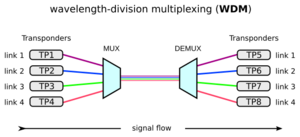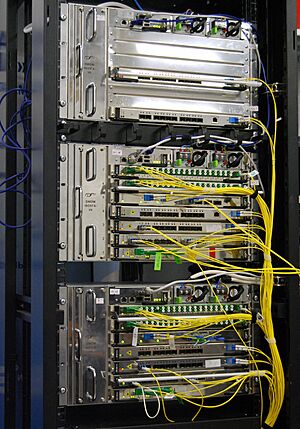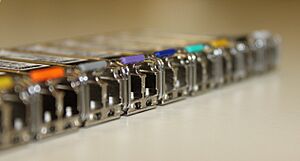Wavelength-division multiplexing facts for kids
Imagine you have a super-fast internet connection that uses light to send information through tiny glass tubes called optical fibers. Now, what if you wanted to send even more information at the same time without adding more tubes? That's where Wavelength-Division Multiplexing (WDM) comes in!
WDM is a clever technology that lets you send many different light signals through a single optical fiber. It does this by using different "colors" of laser light. Think of it like having many different colored laser pointers, and each color carries its own message, all traveling down the same fiber at once. This way, you can send information in both directions and greatly increase how much data the fiber can carry.
People usually talk about WDM for light signals using "wavelengths" (like colors). For radio signals, they use "frequency." But wavelength and frequency are just different ways to describe the same thing – how light or radio waves travel.
Contents
How WDM Systems Work
A WDM system has two main parts:
- A multiplexer at the start (the transmitter) that combines all the different light signals into one.
- A demultiplexer at the end (the receiver) that splits the combined light signal back into its individual parts.
Some special devices can even do both at the same time!
The idea for WDM first appeared in 1970. By the 1980s, the first WDM systems were being tested. These early systems could only combine two signals. But today's systems are much more powerful! They can handle up to 160 signals, turning a basic internet connection of 100 Gbit/s (gigabits per second) into a super-fast 16 Tbit/s (terabits per second) connection over just one pair of fibers.
WDM systems are very popular with telecommunications companies (like your internet provider). Why? Because they can boost their network's capacity without having to lay down new, expensive fiber cables. They just upgrade the equipment at each end of the fiber. This means they can keep using their existing fiber setup for many years, even as technology gets faster.
Most WDM systems use special single-mode fiber cables. These cables have a very thin core, about 9 micrometers wide.
Types of WDM Systems
There are three main types of WDM, based on how closely packed the "colors" (wavelengths) of light are:
- Normal WDM (sometimes called BWDM) uses two main wavelengths, 1310 nm and 1550 nm, on one fiber.
- Coarse WDM (CWDM) spreads out its wavelengths more. It can use up to 16 channels across different "windows" of the fiber.
- Dense WDM (DWDM) packs its wavelengths very closely together. It uses the C-Band (1530 nm-1565 nm) and can have 40 channels or even 80 channels packed tightly. Some super-advanced systems can even use 12.5 GHz spacing!
The main difference between CWDM and DWDM is how close the wavelengths are. CWDM uses wider spacing, which means the equipment can be simpler and cheaper. But because the wavelengths are spread out, it's harder to boost the signal over long distances. DWDM, with its tight spacing, can use special optical amplifiers to send signals much further.
Coarse WDM (CWDM)
Coarse Wavelength-Division Multiplexing (CWDM) uses wavelengths that are spaced quite far apart. This means it doesn't need super-fancy (and expensive) amplifiers to work.
In 2002, a group called ITU set a standard for CWDM wavelengths. They range from 1270 nm to 1610 nm, with a 20 nm gap between each one. Newer types of fiber cables can handle all 18 of these channels, even those that older fibers struggled with.
Because CWDM signals aren't amplified much, they usually work best for shorter distances, like up to 60 km. This makes them great for networks within cities or towns.
CWDM Uses
CWDM is used in many places, like cable television networks. Here, different wavelengths send signals "downstream" (to your TV) and "upstream" (from your home). For example, the downstream signal might be at 1310 nm, and the upstream signal at 1550 nm.
Some CWDM systems don't even need electrical power! They use simple optical parts like filters to separate the wavelengths. This "passive CWDM" is being used to bring fiber optic internet right to people's homes.
Dense WDM (DWDM)
Dense Wavelength-Division Multiplexing (DWDM) is all about packing as many light signals as possible into one fiber. It uses wavelengths in the 1550 nm band, which is perfect for special amplifiers called erbium-doped fiber amplifiers (EDFAs).
EDFAs are amazing because they can boost any light signal in their range, no matter how fast the data is. This means that if you have a DWDM link with EDFAs, you can upgrade the speed of your internet connection just by changing the equipment at the ends, without touching the fiber or the amplifiers in the middle! This makes DWDM very cost-effective for high-speed, long-distance networks.
How DWDM Systems Work
A basic DWDM system has a few key parts:
- A DWDM terminal multiplexer: This is where your data signals (like internet traffic) come in. It converts each signal into a specific "color" of light in the 1550 nm band. Then, it combines all these different colored lights into one super-signal to send down the fiber.
- Intermediate line repeaters: These are placed every 80-100 km along the fiber. They use EDFAs to boost the light signal, making sure it doesn't get too weak as it travels.
- An intermediate optical terminal (or optical add-drop multiplexer): This is another remote spot where the signal is amplified. In more advanced systems, you can even "drop" (remove) some light signals or "add" new ones at these points.
- A DWDM terminal demultiplexer: At the other end, this device splits the super-signal back into its individual colored light signals. These are then sent to the client systems that need the data.
- Optical Supervisory Channel (OSC): This is a separate, special light signal that travels along with the main data. It carries important information about the network, like how strong the signals are or if there are any problems. It's like a control channel for the whole system.
DWDM systems need to be very precise with their wavelengths because they are packed so closely together. This means the lasers that create the light signals need to be kept at a very stable temperature. Because DWDM offers huge capacity, it's often used for the main "backbone" of the internet.
Smart DWDM: ROADMs
Imagine you have a DWDM system, and you want to change which light signals go where. In older systems, you'd have to manually swap out parts, which could be a big hassle.
But with a Reconfigurable Optical Add-Drop Multiplexer (ROADM), network operators can change things remotely with just a few commands. This means they can add or remove wavelengths without stopping the other signals that are already passing through. It's like being able to change train tracks without stopping the trains!
Optical Cross Connects (OXCs)
In very complex networks, where many fibers connect in a mesh-like way, you need a device to route signals from one input to the right output. These are called optical cross connects (OXCs). They help direct the light signals to their correct paths.
Enhanced WDM
Some companies, like Cisco, have created "Enhanced WDM" systems. These combine different types of WDM technologies. For example, they might use CWDM for slower connections and DWDM for super-fast 10 Gbit/s or even 100 Gbit/s connections. This allows for a mix of speeds and longer distances.
Shortwave WDM
Shortwave WDM uses different wavelengths in a shorter range (846 to 953 nm). It can work with special fibers or with two regular fibers.
Transceivers and Transponders
- Transceivers: Most communication needs to go both ways. So, at each end of a fiber, you need a device that can both send (transmit) and receive light signals. This combined device is called a transceiver. For WDM on a single fiber, the transceivers at each end must use different wavelengths so they don't interfere with each other.
- Transponders: Sometimes, the signals coming into a WDM system are already light signals, but at a different wavelength. A transponder's job is to convert these incoming light signals into the specific wavelength needed for the WDM system. It's like a translator for light signals. Some transponders can even clean up and boost the signal as they convert it.
Images for kids





